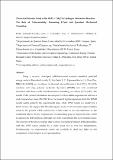| dc.contributor.author | Gonzalez-Lavado, Eloisa | |
| dc.contributor.author | Corchado, Jose C. | |
| dc.contributor.author | Suleimanov, Yury V. | |
| dc.contributor.author | Green, William H. | |
| dc.contributor.author | Espinosa-Garcia, Joaquin | |
| dc.date.accessioned | 2014-12-18T19:21:26Z | |
| dc.date.available | 2014-12-18T19:21:26Z | |
| dc.date.issued | 2014-04 | |
| dc.date.submitted | 2014-04 | |
| dc.identifier.issn | 1089-5639 | |
| dc.identifier.issn | 1520-5215 | |
| dc.identifier.uri | http://hdl.handle.net/1721.1/92389 | |
| dc.description.abstract | Using a recently developed full-dimensional accurate analytical potential energy surface [Gonzalez-Lavado, E., Corchado, J. C., and Espinosa-Garcia, J. J. Chem. Phys. 2014, 140, 064310], we investigate the thermal rate coefficients of the O([superscript 3]P) + CH[subscript 4]/CD[subscript 4] reactions with ring polymer molecular dynamics (RPMD) and with variational transition-state theory with multidimensional tunneling corrections (VTST/MT). The results of the present calculations are compared with available experimental data for a wide temperature range 200–2500 K. In the classical high-temperature limit, the RPMD results match perfectly the experimental data, whereas VTST results are smaller by a factor of 2. We suggest that this discrepancy is due to the harmonic approximation used in the present VTST calculations, which leads to an overestimation of the variational effects. At low temperatures the tunneling plays an important role, which is captured by both methods, although they both overestimate the experimental values. The analysis of the kinetic isotope effects shows a discrepancy between both approaches, with the VTST values smaller by a factor about 2 at very low temperatures. Unfortunately, no experimental results are available to shed any light on this comparison, which keeps it as an open question. | en_US |
| dc.description.sponsorship | Gobierno de Extremadura, Spain | en_US |
| dc.description.sponsorship | La Federacion Espanola de Enfermedades Raras (Project IB10001) | en_US |
| dc.description.sponsorship | United States. Dept. of Energy. Office of Basic Energy Sciences (Combustion Energy Research Center Award DE-SC0001198) | en_US |
| dc.language.iso | en_US | |
| dc.publisher | American Chemical Society (ACS) | en_US |
| dc.relation.isversionof | http://dx.doi.org/10.1021/jp5028965 | en_US |
| dc.rights | Article is made available in accordance with the publisher's policy and may be subject to US copyright law. Please refer to the publisher's site for terms of use. | en_US |
| dc.source | Prof. Green via Erja Kajosalo | en_US |
| dc.title | Theoretical Kinetics Study of the O([superscript 3]P) + CH[subscript 4]/CD[subscript 4] Hydrogen Abstraction Reaction: The Role of Anharmonicity, Recrossing Effects, and Quantum Mechanical Tunneling | en_US |
| dc.type | Article | en_US |
| dc.identifier.citation | Gonzalez-Lavado, Eloisa, Jose C. Corchado, Yury V. Suleimanov, William H. Green, and Joaquin Espinosa-Garcia. “Theoretical Kinetics Study of the O([superscript 3]P) + CH[subscript 4]/CD[subscript 4] Hydrogen Abstraction Reaction: The Role of Anharmonicity, Recrossing Effects, and Quantum Mechanical Tunneling.” The Journal of Physical Chemistry A 118, no. 18 (May 8, 2014): 3243–3252. | en_US |
| dc.contributor.department | Massachusetts Institute of Technology. Department of Chemical Engineering | en_US |
| dc.contributor.approver | Green, William H. | en_US |
| dc.contributor.mitauthor | Suleimanov, Yury V. | en_US |
| dc.contributor.mitauthor | Green, William H. | en_US |
| dc.relation.journal | The Journal of Physical Chemistry A | en_US |
| dc.eprint.version | Author's final manuscript | en_US |
| dc.type.uri | http://purl.org/eprint/type/JournalArticle | en_US |
| eprint.status | http://purl.org/eprint/status/PeerReviewed | en_US |
| dspace.orderedauthors | Gonzalez-Lavado, Eloisa; Corchado, Jose C.; Suleimanov, Yury V.; Green, William H.; Espinosa-Garcia, Joaquin | en_US |
| dc.identifier.orcid | https://orcid.org/0000-0001-9813-8574 | |
| mit.license | PUBLISHER_POLICY | en_US |
| mit.metadata.status | Complete | |
